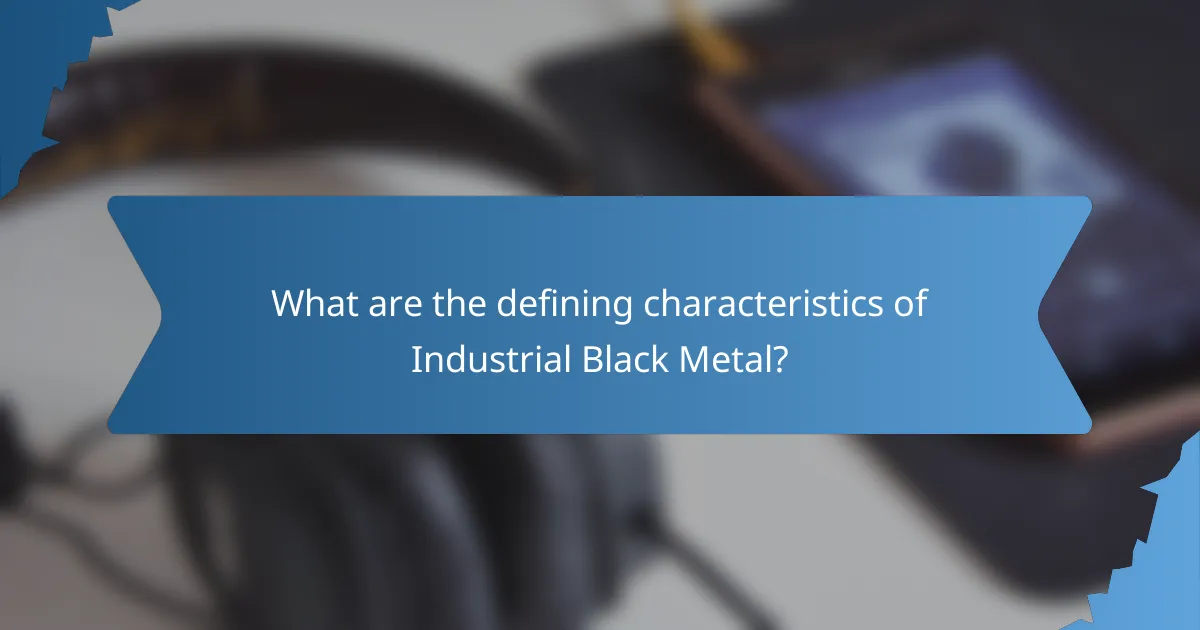Industrial black metal is a genre that merges the aggressive intensity of black metal with the mechanical and electronic influences of industrial music. This unique sound is defined by harsh textures and experimental approaches, utilizing electronic tools to enhance its atmospheric qualities. Pioneering bands in this genre have significantly shaped its evolution, creating a distinctive fusion that continues to inspire new artists.

How does Industrial Black Metal incorporate electronic elements?
Industrial black metal blends harsh textures with electronic elements to create a unique sound that is both aggressive and atmospheric. This genre utilizes various electronic tools and techniques to enhance its sonic landscape, resulting in a distinctive fusion of metal and electronic music.
Use of synthesizers
Synthesizers play a crucial role in industrial black metal, providing a wide range of sounds that can complement the aggressive guitar riffs and harsh vocals. They can produce everything from eerie ambient pads to distorted leads, adding depth and complexity to the music. Bands often experiment with analog and digital synthesizers to achieve unique tonal qualities.
For example, using a modular synthesizer allows for intricate sound design, enabling musicians to craft textures that are not easily replicated with traditional instruments. This experimentation is key to developing a signature sound within the genre.
Integration of samples
Sampling is a common technique in industrial black metal, where artists incorporate sounds from various sources, including movies, speeches, or field recordings. These samples can enhance the thematic elements of the music, creating a more immersive experience. The use of samples can also provide a stark contrast to the live instrumentation, emphasizing the genre’s industrial roots.
When integrating samples, it’s essential to ensure they fit seamlessly within the mix. Careful consideration of timing and volume can prevent samples from overpowering the core elements of the track.
Digital effects processing
Digital effects processing is vital for shaping the sound in industrial black metal. Effects such as reverb, distortion, and delay can transform basic sounds into complex auditory experiences. These effects can be applied to both instruments and vocals, enhancing the overall atmosphere of the music.
Using a digital audio workstation (DAW) allows for precise control over effects, enabling artists to experiment with various combinations. It’s important to strike a balance; over-processing can lead to a muddy mix, while under-processing may result in a lack of depth.
Rhythmic programming
Rhythmic programming is a hallmark of industrial black metal, often featuring programmed drums and percussion that complement the aggressive guitar work. This approach allows for precise control over tempo and dynamics, creating intricate patterns that enhance the intensity of the music. Artists frequently use drum machines or software to craft complex rhythms that would be challenging to perform live.
When programming rhythms, consider incorporating variations to maintain listener interest. Subtle changes in patterns or adding syncopation can elevate the overall impact of the track.
Collaboration with electronic artists
Collaborating with electronic artists can bring fresh perspectives and techniques to industrial black metal. These partnerships often result in innovative soundscapes that blend the raw energy of metal with the precision of electronic music. Such collaborations can introduce new elements, such as glitch effects or ambient textures, enriching the overall sound.
When seeking collaborations, look for artists who share a similar vision but bring different skills to the table. This synergy can lead to unique compositions that push the boundaries of the genre.

What are the defining characteristics of Industrial Black Metal?
Industrial Black Metal combines the aggressive elements of black metal with the mechanical and electronic influences of industrial music. This genre is characterized by its harsh textures, unique sound, and a fusion of extreme vocal styles, distorted guitars, and atmospheric layers.
Harsh vocal styles
Harsh vocal styles are a hallmark of Industrial Black Metal, often featuring guttural growls, shrieks, and spoken word elements. These vocal techniques create an intense emotional atmosphere, enhancing the music’s dark themes. Vocal delivery can vary widely, from high-pitched screams to deep, menacing tones, contributing to the genre’s distinctive sound.
Heavy guitar distortion
Heavy guitar distortion is essential in creating the aggressive sound typical of Industrial Black Metal. Guitars are often heavily processed with effects like fuzz and overdrive, resulting in a thick, saturated tone. This distortion not only adds to the intensity but also blends seamlessly with electronic elements, creating a wall of sound that defines the genre.
Complex song structures
Complex song structures are prevalent in Industrial Black Metal, often deviating from traditional verse-chorus formats. Songs may feature abrupt tempo changes, unconventional time signatures, and extended instrumental sections. This complexity allows for a dynamic listening experience, keeping the audience engaged and emphasizing the genre’s experimental nature.
Atmospheric soundscapes
Atmospheric soundscapes play a crucial role in establishing the mood in Industrial Black Metal. Layers of synthesizers, samples, and ambient sounds create a haunting backdrop that complements the harsh musical elements. These soundscapes can evoke feelings of desolation or industrial environments, enhancing the thematic depth of the music.
Industrial percussion
Industrial percussion is characterized by its use of unconventional sounds and rhythms, often incorporating electronic beats and samples. Drumming techniques may include machine-like precision and syncopation, contributing to the genre’s mechanical feel. This rhythmic complexity supports the overall intensity of the music, making it both danceable and aggressive.

Which bands are pioneers of Industrial Black Metal?
Pioneers of Industrial Black Metal blend aggressive metal with electronic elements, creating a distinct sound characterized by harsh textures and experimental approaches. Notable bands in this genre have shaped its evolution and continue to influence new artists.
Thorns
Thorns, a Norwegian band formed in the early 1990s, is often credited with merging black metal and industrial sounds. Their music features a unique combination of atmospheric elements and mechanical rhythms, which set a precedent for the genre.
Their 1997 album, “Thorns,” showcases a blend of harsh vocals and intricate electronic soundscapes, influencing many subsequent acts in Industrial Black Metal. The band’s innovative approach emphasizes the use of technology in music production.
Aborym
Aborym is an Italian band that emerged in the mid-1990s, known for their aggressive fusion of black metal and electronic music. They incorporate a wide range of influences, from industrial to ambient, creating a complex auditory experience.
Their album “With No Human Intervention” exemplifies their style, featuring distorted guitars, electronic beats, and samples that challenge traditional black metal norms. Aborym’s work is essential for understanding the genre’s evolution and diversity.
Godflesh
Godflesh, a British band formed in the late 1980s, is a significant influence on both industrial and metal genres. Their heavy use of downtuned guitars and drum machines creates a sound that is both crushing and hypnotic.
Albums like “Streetcleaner” and “Pure” showcase their innovative approach, blending elements of industrial noise with metal’s intensity. Godflesh’s impact on Industrial Black Metal is profound, as they paved the way for many artists to explore similar soundscapes.
Black Lung
Black Lung is an American project that combines elements of industrial music with black metal, known for its raw sound and experimental approach. Their music often features harsh vocals and abrasive textures, creating a visceral listening experience.
Their self-titled album highlights their ability to merge aggressive metal riffs with electronic influences, showcasing the potential of Industrial Black Metal to push boundaries. Black Lung’s work is a testament to the genre’s versatility and innovation.
Psychic TV
Psychic TV, formed in the early 1980s, is a band that blends various genres, including industrial, experimental, and electronic music. While not strictly a black metal band, their influence on the genre is notable due to their avant-garde approach and incorporation of dark themes.
With albums like “Force the Hand of Chance,” they explore the intersection of sound and ideology, which resonates with the ethos of Industrial Black Metal. Their experimental nature has inspired countless artists to explore darker, more complex soundscapes.

How has Industrial Black Metal evolved in Australia?
Industrial Black Metal in Australia has developed a distinct identity, blending harsh textures and electronic elements with local influences. This genre has seen a rise in unique sounds, driven by the emergence of local bands and a growing underground scene.
Emergence of local bands
Local bands have been pivotal in shaping the Industrial Black Metal scene in Australia. Groups such as Portal and Abominator have incorporated electronic elements and experimental sounds, pushing the boundaries of the genre.
These bands often perform in underground venues, fostering a tight-knit community that supports innovative music. Their unique interpretations of Industrial Black Metal reflect Australia’s diverse cultural landscape, integrating influences from both local and international scenes.
As these bands gain recognition, they contribute to a broader acceptance of Industrial Black Metal within the Australian music industry, encouraging new artists to explore this genre. The collaboration between local musicians and international acts further enriches the sound and texture of the music produced.
